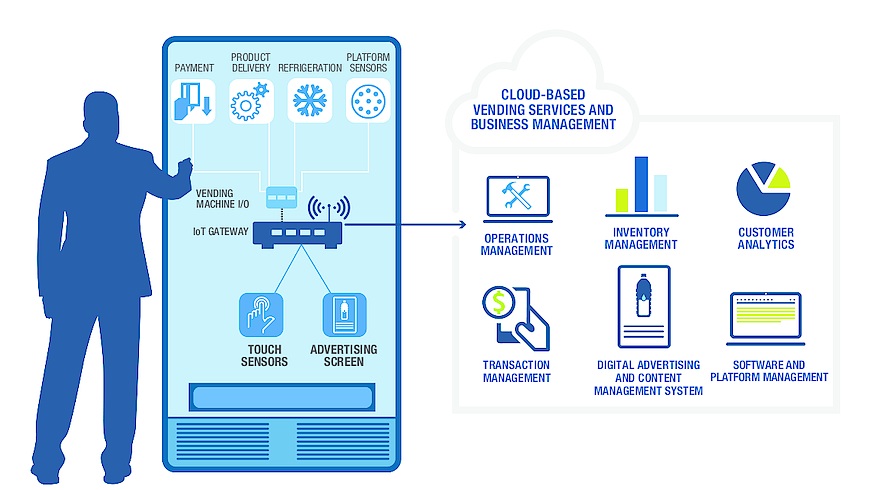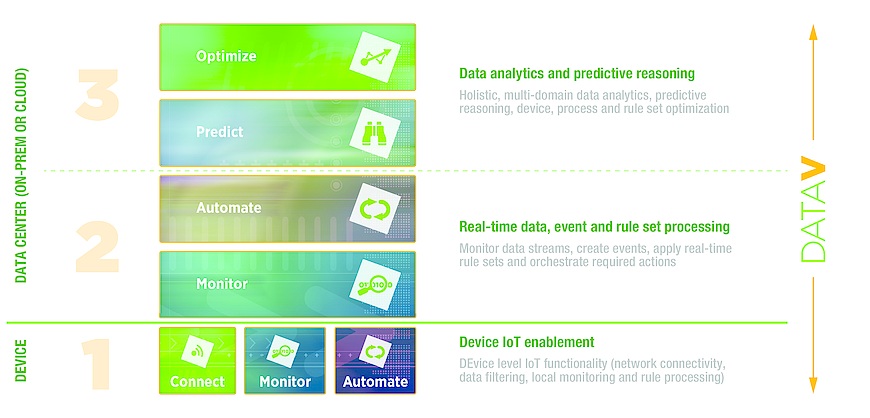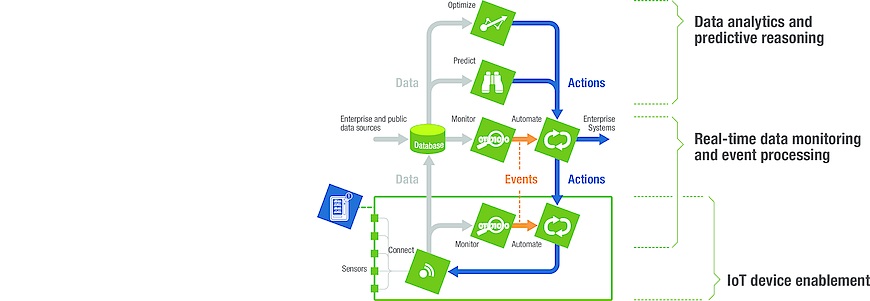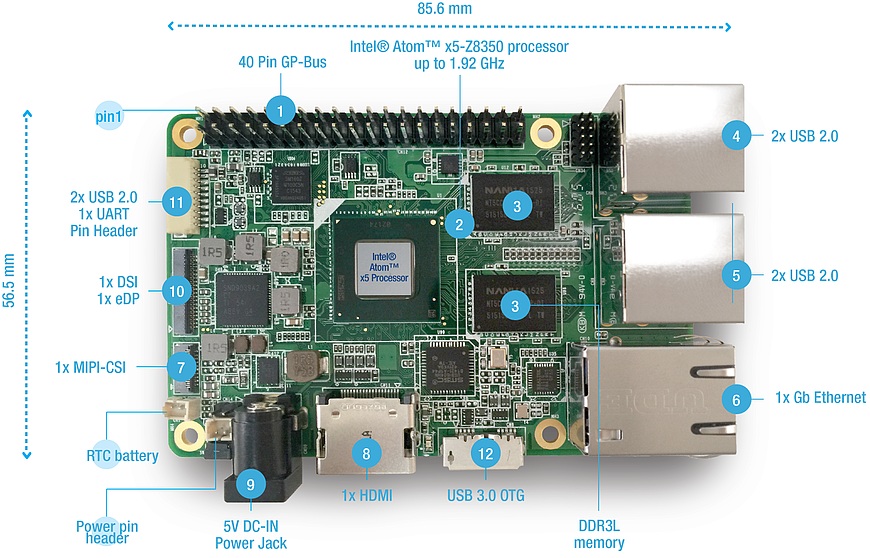Vending Machine IoT Makeovers
The next generation of intelligent vending machines offers tremendous opportunities for business transformation through the Internet of Things (IoT) and cloud-based technologies. Vending machine owners and operators can look forward to more effective ways to engage customers, increase sales, and save money through remote management and predictive maintenance. Advanced data analytics will help them better match machines and stock to each location, as well as obtain valuable insights on the effectiveness of promotions, pricing, location, weather, season, and other factors.
While this is great news for purchasers of the latest vending machine designs, many operators have large vending machine fleets with years of life left in them. These operators need ways to update these machines now to profit from IoT advantages (Figure 1).

Figure 1. Vending machine operators are looking for ways to connect legacy machines to the IoT to profit from its many advantages.
This article examines the challenges of retrofitting IoT technology into legacy vending machines. We consider a distributed intelligent vending retrofit solution engineered by Bsquare in collaboration with AAEON. We look at how this solution uses Bsquare DataV* – a complete IoT software stack – to address device enablement, business logic processing, and data analytics. We discuss how this solution enables operators to extract data from field equipment and integrate the data into business processes and workflows to achieve new operational efficiencies and business insights. We then explore the solution’s innovative, cost-effective hardware platform that combines an UP board based on the Intel® Atom™ x5-Z8350 processor with a vending machine expansion board based on the Intel® Reference Design for Intelligent Vending.
The Winds of Change in Vending
Businesses of all types are recognizing the importance of developing and implementing an IoT strategy. For some, this implementation takes root in product development as they create new IoT-connected offerings. Others are faced with finding a way to extend the benefits of the IoT to legacy assets developed in an unconnected world.
Good examples of the latter group are vending machine operators. Vending machines continue to be a growing segment in retail as people in today’s busy world seek fast, tasty snacks, meals, and beverages. Vending machines are also increasingly used to peddle non-food items. Businesses seeking new ways to expand sales with minimum distribution and labor costs are turning to vending machines to sell everything from disposable diapers and medicines to headphones and other electronics.
To drive down operating costs and improve sales and profits, vending machine operators are seeking a better understanding of their operations. To gather, analyze, and interpret the necessary data for such business insight, they are looking into IoT solutions.
Where the IoT Can Help
With traditional vending machines, information is collected when machines are restocked and serviced. This creates a serious delay in inventory monitoring. It also impacts sales reporting compliance in jurisdictions requiring vending machine operators to report taxes on sales on a timely basis. Infrequent visits also make it hard to know when a machine is malfunctioning and losing sales.
Traditional vending machines require service visits to update prices or begin a promotion, such as two-for-one deals. Since many vending machine owners rely on third parties to stock machines, there is no safeguard to prevent the vending of unauthorized products.
Obviously a solution is needed that can monitor machines in real-time for accurate data on inventory, sales, and machine health. The solution must then deliver that information to operators. That solution is the IoT.
IoT Challenges for Vending
Vending machines frequently operate in areas where bandwidth is inconsistent or expensive, such as public transit platforms, stadiums, freeway rest stops, or corridors in shopping malls. These types of locations pose problems for IoT solutions solely dependent on the cloud for data processing.
Adding intelligence to a machine also increases complexity. While the cost of sensors continues to drop, it is not trivial to outfit an entire cabinet with sensors on every shelf, slot, or spiral. In addition, software versions and configurations require periodic updates. These considerations raise the stakes for retailers seeking to retrofit existing vending machines for today’s connected world.
A Vending Machine Makeover
Working with AAEON, Bsquare developed an innovative retrofit kit for a global vending machine owner. Bsquare also served as the system integrator for the solution targeted for an initial deployment that could potentially number in the tens of thousands across Europe.
The retrofit kit uses Bsquare DataV*, an end-to-end IoT solution that handles distributed processing and analysis of data both on the machine and in the cloud. In addition, DataV enables remote device management.
DataV collects raw device data at the network edge, applies rules and logic to make the data meaningful and actionable, and then delivers it to the cloud, applications, and everywhere else it needs to go. Taking a modular software approach, DataV includes five product components to bridge the gap between data-generating sensors and the business. Each component is named for the task it does: connect, monitor, automate, predict, or optimize (Figure 2).

Figure 2. Taking a modular approach to software, DataV delivers five key functions for bridging edge sensors and the business.
Analytics at Work
To eliminate the time and expense of equipping each machine with multiple shelf, slot, or spiral sensors, Bsquare came up with a unique alternative – using a camera and software to count and identify vended products. DataV’s data analytics determines the unique characteristics of each item and stores it as a pattern. As products are vended, a picture is taken and compared against a library of product patterns. This product recognition enables accurate inventory reporting and identifies unauthorized and incorrectly stocked products.
Given the bandwidth constraints of vending machines, DataV performs image recognition directly on the machine itself, sending only information about the image to the cloud. By minimizing data uploads, the retrofit kit avoids the transmission and storage costs of large image files (Figure 3). As new products are introduced and patterns developed, DataV handles the provisioning and management of these as well.

Figure 3. By performing photo analysis locally, Bsquare DataV eliminates the cost of transmission and storage of large image files in the cloud.
Advantages for Vending Machine Operators and Owners
Providing real-time data, the Bsquare solution enables vending machine operators to understand current and historical product sales, as well as determine the effectiveness of their planogram. DataV’s analytics can predict how changes in the layout of machine inventory will affect overall sales activity and provide prescriptive insights on how to maximize performance. The solution can also factor in data from existing enterprise systems and external sources tracking weather, day of week, time of day, and other parameters. Interpreted data is available to operators on practically any connected device, such as a smartphone, tablet computer, or desktop PC.
Through DataV’s capabilities, the retrofit kit can also enable vending machines to report on inventory levels and maintenance issues to help optimize stocking trips and maintenance schedules. These capabilities can reduce unnecessary service dispatches and ensure product availability for customer satisfaction. DataV is also able to remotely manage firmware and configuration updates, as well as use algorithms to predict the imminent failure of mechanical components.
The retrofit kit also enables remote implementation of promotions and price changes without a truck roll. Through a web interface, operators can change prices and apply or remove promotions on a machine-by-machine basis, or all at once on groups of machines.
A Board with an Eye for Inventory
To operate the camera and enable the analytics and IoT gateway functions, the retrofit kit uses an UP board. This credit-card-sized board originates from a collaboration between AAEON and Intel. It is now supported by the UP maker community. The AAEON UP board design used in the retrofit kit runs Linux* and includes additional I/O capabilities.
UP bridges the gap between the world of prototypes and the world of high-grade mass-produced embedded system solutions. The UP board features up to 2 GB RAM, up to 32 GB eMMC, four USB 2.0, USB 3.0 On-the-Go (OTG), Ethernet, HDMI, and a Display Serial Interface (DSI) – see Figure 4. A camera interface supports the kit's camera through the MIPI-CSI specification.

Figure 4. This diagram of AAEON's UP board shows its rich I/O options and diminutive size.
The board uses an Intel Atom x5-Z8350 processor. Launched at the start of 2016, this 1.44 GHz 64-bit system-on-chip (SoC) with a 1.92 GHz burst frequency features Intel’s latest 14 nm process technology. The processor’s support for 64-bit applications helps deliver higher performance and greater functionality across a wide range of IoT use cases.
A power envelope of just 2 W makes it ideal for constrained environments like vending machines. Four CPU cores and 2 MB of last-level cache (LLC) enable fast computing and efficient multi-tasking. Intel® Burst Technology dynamically optimizes compute and graphics performance to handle peak loads and deliver lower overall power consumption.
A standard PC operating temperature range of 0 °C to 60 °C makes the UP board a reliable and flexible solution for all but the most extreme vending machine locations. The board also includes a real-time clock (RTC) and support for Preboot eXecution Environment (PXe) and Wake-on-LAN for remote management.
Communications Within and Without
Today’s vending machines employ a wide range of bus protocols (CAN, ccTalk, Protocol A, MDB, and USB, to name a few) to communicate with the vending machine controller (VMC). To replace the legacy design’s VMC with the UP board and enable communications with machine peripherals, the retrofit kit uses a vending machine I/O (VMI) board manufactured by AAEON based on the Intel Reference Design for Intelligent Vending.
The VMI board is a low-cost design that handles protocol conversion and provides a high-level of I/O flexibility. It connects analog and digital signals from product drops, coin and bill collection, and thermometers not otherwise monitored or controlled by the VMC.
Potential to Do More
The combined solution (UP board and VMI) creates the potential for new user interface (UI) options ranging from keypads and two-line displays to touchscreens. With a little additional engineering and software, the retrofit kit could modernize legacy machines with displays enabling advertising revenue through digital advertising. The display could connect to the IoT and cloud through the UP board’s HDMI and DSI interfaces. DataV could then capture and analyze data on the customer interactions and provide important proof-of-play data for advertisers.
A True IoT Makeover for Legacy Vending Machines
The vending machine retrofit kit designed by Bsquare and AAEON provides an excellent way to help vending machine owners and operators take advantage of IoT advances on existing machines. The kit offers a ready solution for employing distributed analytics for real-time monitoring of compliance, sales, inventory management, and predictive part failure in environments where IoT connections are inconsistent or expensive.